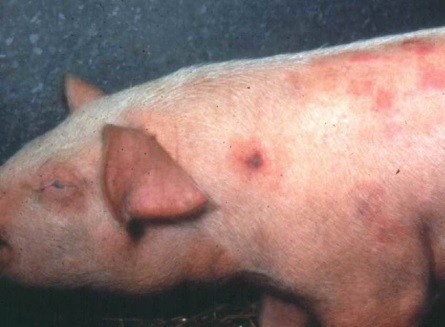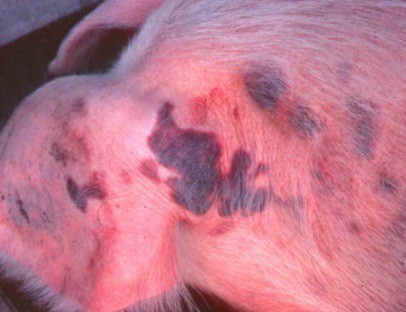Erysipelas
Disease Overview
Swine erysipelas is caused by Erysipelothrix rhusiopathiae, a bacterium that can grow either anaerobically or aerobically. It occurs in most parts of the world in growing and adult swine and can causes skin lesions in humans (rare). It survives outside the pig in manure and soil for up to six months but most infections are from pig to pig. Up to 20% of normal healthy pigs carry the organisms in their tonsils, from where they may be passed out in the dung or via mucous from the mouth, causing low level environmental contamination. Water contaminated with the organism also aids the spread of infection.
Signs of disease range from very mild to very severe depending on the bacterial strain.

Contributing Factors
- Adverse environmental changes
- Poor nutrition
- Fluctuating temperatures
- Movement and mixing
- Continuous population of houses
- Wet dirty pens
Erysipelas enters the body through the tonsils, naturally occurring breaks in the integrity of the small intestine, or often through wounds associated with fighting.
Disease outbreaks may be acute or chronic. Acute outbreaks are characterised by sudden and unexpected deaths, fever, painful joints, and skin lesions that vary from generalized blueish colour to the often-described diamond skin lesions. Chronic Erysipelas usually occurs after acute outbreaks, characterised by enlarged joints and lameness. Another form of chronic Erysipelas is where a vegetative growth forms on the valves of the heart. Initially pigs with heart valvular lesions may have no clinical signs; however, when exerted physically they may show signs of respiratory distress and suddenly succumb to the infection. Maternal immunity can last up to 3 months of age in young piglets.
Clinical Signs
Usually, individual pigs or small groups are affected. Acute disease
- Diamond skin lesions
- High fever (41 to 42oC)
- Sudden death
- Pain in the legs: stilted, stiff movement, arched back
- Inappetence: dry faeces (diarrhoea in young animals)
- Abortion
- Septicaemia
Subacute disease
- As acute disease but less pronounced
- Infertility
- Inappetence
- In mild infections, disease may even go unnoticed (subclinical infection)
Chronic disease
- Arthritis may be mild or severe
- Heart valve lesions
- Chronic skin lesions- areas of skin separate and fall off
- Reduced growth rate

